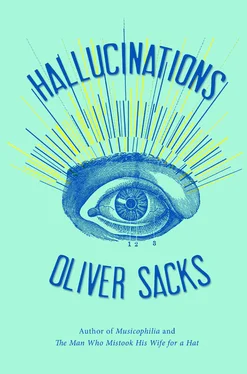There has always been inconsistency in defining delirium, and as Dimitrios Adamis and his colleagues pointed out in their review of the subject, it has frequently been confused with dementia and other conditions. Hippocrates, they wrote, “used about sixteen words to refer to and name the clinical syndrome which we now call delirium.” There was additional confusion with the medicalization of insanity in the nineteenth century, as German Berrios has noted, so that insanity was referred to as délire chronique . Even now the terminology is ambiguous, so that delirium is sometimes called “toxic psychosis.”
Just such an appearance of delirious images when closing the eyes, and their disappearance when the eyes are opened, is described by John Maynard Keynes in his memoir “Dr. Melchior”:
By the time we were back in Paris, I was feeling extremely unwell and took to my bed two days later. High fever followed.… I lay in my suite in the Majestic, nearly delirious, and the image of the raised pattern on the nouveau art wall-paper so preyed on my sensibilities in the dark that it was a relief to switch on the light and, by perceiving the reality, to be relieved for a moment from the yet more hideous pressure of its imagined outlines.
In a prefatory note to a later edition, Waugh wrote: “Three years ago Mr. Waugh suffered a brief bout of hallucinations resembling what is here described.… Mr. Waugh does not deny that ‘Mr. Pinfold’ is largely based on himself.” Thus we may accept The Ordeal as an autobiographic “case history” of a psychosis, an organic psychosis, albeit one written with a mastery of observation and description — and a sense of plot and suspense — that no purely medical case history has.
W. H. Auden once said that Waugh had “learned nothing” from his ordeal, but it at least enabled him to write a richly comic memoir, a new departure quite unlike anything he had written previously.
The Reverend Henslow was a son of the botanist John Stevens Henslow, who was Darwin’s teacher at Cambridge and was instrumental in getting him a position aboard the Beagle .
Feeling that hypnagogic hallucinations could extend and enrich the imagination, Poe would jerk himself suddenly to full wakefulness while hallucinating, so that he could make note of the extraordinary things he saw, and he often brought these into his poems and short stories. Poe’s great translator, Baudelaire, was also fascinated by the unique quality of such visions, especially if they were potentiated by opium or hashish. A whole generation in the early nineteenth century (including Coleridge and Wordsworth, as well as Southey and De Quincey) was influenced by such hallucinations. This is explored by Alethea Hayter in her book Opium and the Romantic Imagination and by Eva Brann in her magisterial The World of the Imagination: Sum and Substance .
Hypnopompic hallucinations are far less common than hypnagogic ones, and some people have hypnagogic hallucinations upon awakening, or hypnopompic ones while falling asleep.
Spinoza, in the 1660s, described a similar hallucination in a letter to his friend Peter Balling:
When one morning, after the day had dawned, I woke up from a very unpleasant dream, the images, which had presented themselves to me in sleep, remained before my eyes just as vividly as though the things had been real, especially the image of a certain black and leprous Brazilian whom I had never seen before. This image disappeared for the most part when, in order to divert my thoughts, I cast my eyes on a book or something else. But as soon as I lifted my eyes again, without fixing my attention on any particular object, the same image of this same negro appeared with the same vividness again and again, until the head of it finally vanished.
Bill Hayes, in his book Sleep Demons , cites an even earlier reference to irresistible, overwhelming sleepiness and probable cataplexy — “It falls upon them in the midst of mirth” — from a little-known 1834 book, The Philosophy of Sleep , by the Scottish physician Robert Macnish.
A key figure in the narcolepsy world is Michael Thorpy, a physician whose many books on narcolepsy and other sleep disorders have grown out of a lifetime of experience directing a sleep disorders clinic at Montefiore Medical Center in the Bronx.
This simple equation had to be modified later, when it was found that dreams — albeit of a somewhat different kind — could also occur in non-REM sleep.
Many of H. G. Wells’s short stories also involve guilt hallucinations. In “The Moth,” a zoologist who feels himself responsible for the death of his lifelong rival is haunted and finally driven mad by a giant moth that no one else can see, a moth of a genus unknown to science; but in his lucid moments, he jokes that it is the ghost of his deceased rival.
Dickens, a haunted man himself, wrote five books on this theme, the best known of these being A Christmas Carol . And in Great Expectations , he provides a dramatic account of Pip’s vision after his first, horrified encounter with Miss Havisham:
I thought it a strange thing then, and I thought it a stranger thing long afterwards. I turned my eyes — a little dimmed by looking up at the frosty light — towards a great wooden beam in a low nook of the building near me on my right hand, and I saw a figure hanging there by the neck. A figure all in yellow white, with but one shoe to the feet; and it hung so that I could see that the faded trimmings of the dress were like earthy paper, and that the face was Miss Havisham’s, with a movement going over the whole countenance as if she were trying to call me. In the terror of seeing the figure, and in the terror of being certain that it had not been there a moment before, I at first ran from it, and then ran towards it. And my terror was greatest of all when I found no figure there.
Losing a spouse, of course, is one of the most stressful of life events, but bereavement may happen in many other situations, from the loss of a job to the loss of a beloved pet. A friend of mine was very upset when her twenty-year-old cat died, and for months she “saw” the cat and its characteristic movements in the folds of the curtains.
Another friend, Malonnie K., described a different sort of cat hallucination, after her beloved seventeen-year-old pet died:
Much to my surprise, the next day I was getting ready for work and she appeared at the bathroom door, smiled and meowed her usual “good morning.” I was flabbergasted. I went to tell my husband and when I returned, of course, she was no longer there. This was upsetting to me because I have no history of hallucinations and thought I was “above” such things. However, I have accepted that this experience was, perhaps, a result of the phenomenally close bond that we had developed and sustained over nearly two decades. I must say, I am so grateful that she stopped by one last time.
Loss, longing, and nostalgia for lost worlds are also potent inducers of hallucinations. Franco Magnani, “the memory artist” I described in An Anthropologist on Mars , had been exiled from Pontito, the little village where he grew up, and although he had not returned to it in decades, he was haunted by continual dreams and hallucinations of Pontito — an idealized, timeless Pontito, as it looked before it was invaded by the Nazis in 1943. He devoted his life to objectifying these hallucinations in hundreds of nostalgic, beautiful, and uncannily accurate paintings.
Читать дальше












